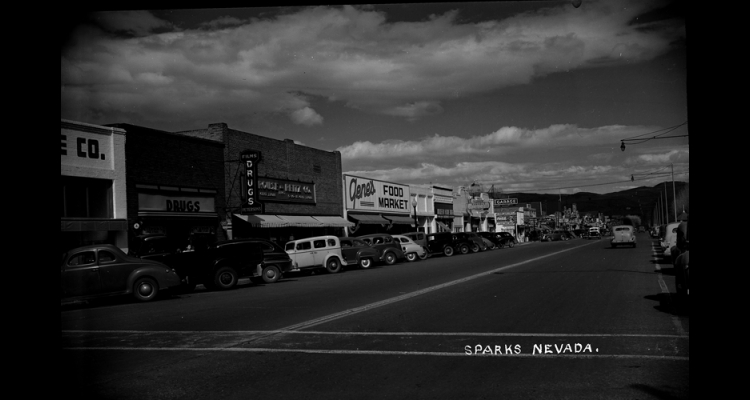Sparks
The settlement of Sparks sprang up virtually overnight when officials of the Southern Pacific Railroad moved maintenance operations from Wadsworth to an area just east of Reno in the summer of 1904. The railroad cited Wadsworth's outdated structures, lack of a good water supply, and the need to straighten dangerous curves in the track as reasons for moving to Sparks. The little community, which today is one of Nevada's major cities, thrived in the once swampy area east of Reno.
Prior to the coming of the Southern Pacific Railroad, the area that is now Sparks was a marshland populated by a small group of ranches served by a post office. The railroad's first choice for the maintenance station was Reno, but real-estate costs were prohibitive there, so officials opted to create their own real estate by filling in the marshland. Thousands of railroad cars were packed with heavy rock and soil from outlying areas and deposited at the town site to create steadier ground for the houses and buildings.
Once the land was filled and the town platted, the railroad sold lots to workers for one dollar, and on July 4, 1904, the exodus from Wadsworth began. Houses were fully or partially dismantled and moved west via railway to the new town site. Furniture, appliances, livestock, and pets were moved, and even plants and trees were uprooted in preparation for relocation. Residents could be seen cooking on stoves outdoors as they waited for their homes to be reconstructed.
By the end of 1904, the population of Sparks was estimated at 1,200, and the town consisted of a hotel, a library, boarding houses, several stores, and a large roundhouse that could accommodate up to 41 engines. With a permanent infrastructure in place, the town was ready for an official name. East Reno had been the temporary designation for the area, but residents and railroad officials sought to distinguish it from the city to the west. New Wadsworth was proposed, as well as Harriman, after the owner of the Southern Pacific Railroad. When Harriman revealed that he did not want the distinction, the town was officially named after John Sparks, governor of the state of Nevada. The city incorporated in 1905.
Sparks thrived for the next fifty years as a railroad community. During those years, the railroad controlled much business and industry in Sparks, essentially giving it many attributes of a company town. But in 1956, the Southern Pacific Railroad completed its conversion from steam to diesel engines, and maintenance facilities in Sparks were no longer needed. Although Sparks remained a division point on the Southern Pacific, the city lost the core of its economy virtually overnight, forcing a greater reliance on Reno's economy. The railroad continues to operate through Sparks to this day, although it is now the Union Pacific.
Just three years before the railroad shut down its maintenance center, Idaho outlawed slot machines, prompting a restaurant and casino owner named Dick Graves to sell his holdings there and move to Nevada. Graves opened the Nugget in Sparks in 1955, a sixty-seat coffee shop with fifty slot machines on the north side of B Street. Graves hired John Ascuaga, a former employee from Idaho, to manage the property.
The Nugget quickly replaced the railroad as the economic backbone of Sparks. In 1958, it expanded to the south side of B Street, with a 36,000-square-foot casino, five restaurants, and two bars. Ascuaga purchased the property from Graves in 1960, and spent the next forty years turning it into a major hotel and casino that would rival those in neighboring Reno. In 1984, the Nugget completed a 610-room hotel tower, and added a second in 1996. The second tower included 802 rooms and 30,000 square feet of convention space.
Warehousing became an important industry in Sparks at about the same time that the Nugget was rising to power. In 1949 the Nevada Legislature passed the Freeport Law, which allowed for tax-free warehousing for goods sold out of the state. Another law, passed in 1951, gave tax exemptions to industries that assembled goods in designated areas and shipped them out of Nevada. Both laws spurred a significant warehouse industry, which is still important to the city today.
Sparks has managed to convert itself from a railroad town to a tourist destination within the last several decades. The city government, in conjunction with the Nugget and other businesses, has developed downtown's Victorian Square into an event-friendly area. A large flooded gravel quarry, formerly known as Helms Pit, was made into a recreation area called Sparks Marina. The city is also home to Wild Island, the only water park of its kind in northern Nevada.
Sparks survives as a flourishing community, and has rapidly expanded into valleys to its north. It has grown along with Reno, and today there is no geographical distinction between the two cities, and both share strong economic ties with one another. Sparks is planning a major tourist destination near Sparks Marina, which already features several retail outlets, including Scheels, a full-line sporting goods store, and may in the future be home to a large resort, casino, and spa. In 2000, Sparks had 66,346 citizens, contributing to the Reno-Sparks metropolitan area population of 339,486. In 2006, the population of Sparks was estimated at over 83,000.
Article Locations
Related Articles
None at this time.

